Enhancing Vocabulary Knowledge Through Multimodal Learning in Thai Primary Classrooms
- Pawinee Jaemsai
- Apisak Sukying
Abstract
Vocabulary acquisition is a core part of English as a Foreign Language (EFL) learning, especially for young learners who are building their language infrastructure. Many conventional textbook-driven methods focus on rote learning, which can lead to disengaged students and less authentic, less effective learning. It explores the use of multimodal strategies of learning for vocabulary learning of Thai primary school students. Multimodal training combines visual, auditory and kinesthetic aspects; this contributes to reaching different types of learners and favors more efficient ways of processing and retaining information. The study utilized a quasi-experimental research design with 14 first and second graders learning EFL in a Thai public primary school. The intervention consisted of 16 hours of multimodal instruction, which included images, gestures, pronunciation practice, and interactive activities. Data were obtained from pre- and post-intervention tests of vocabulary (receptive and productive vocabulary knowledge), while focus groups were used to probe students’ experiences of the learning process. Quantitative results showed that participants’ receptive and productive vocabulary knowledge increased significantly, and the multimodal instruction approach had a strong influence on them. From the qualitative results, students perceived multimodal learning as enjoyable, motivating, and low in anxiety and thus developed more positive attitudes toward learning English vocabulary. Such results align with the integration of multisensory approaches in primary EFL, confirming their ability to enhance motivation and language achievement across diverse learner characteristics. Practical implications for EFL teachers who aim to integrate student-centered tasks and active learning are provided in this research. In this sense, incorporating multimodal activities into vocabulary teaching can contribute to more inclusive and effective learning environments that help develop young learners’ language skills.
- Full Text:
 PDF
PDF
- DOI:10.5539/jel.v15n1p137
Journal Metrics
Google-based Impact Factor (2021): 1.93
h-index (July 2022): 48
i10-index (July 2022): 317
h5-index (2017-2021): 31
h5-median (2017-2021): 38
Index
Contact
- Grace LinEditorial Assistant
- jel@ccsenet.org
